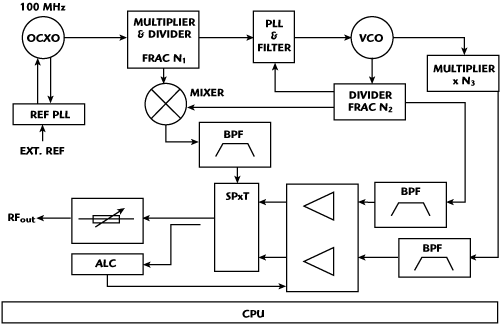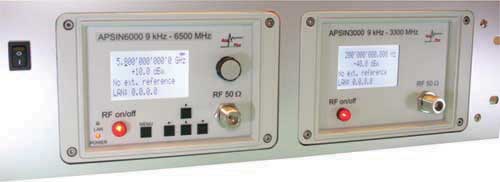 In order to provide customers with a light weight, compact, low cost alternative to high-end laboratory-grade instruments, AnaPico has developed the APSIN range of RF signal generators. First came the APSIN3000 that covers the 9 kHz to 3.3 GHz frequency range, which has now been joined by the newly introduced APSIN6000, which, like its sister version, is a truly portable RF signal generator. The new model completes the company’s product family with an instrument extending the frequency coverage up to 6.4 GHz, especially covering all frequency bands of interest between 5 and 6 GHz. The APSIN6000 is available with an optional internal rechargeable battery that makes it ideally suited for applications outside of the lab, without any compromise in RF performance.
In order to provide customers with a light weight, compact, low cost alternative to high-end laboratory-grade instruments, AnaPico has developed the APSIN range of RF signal generators. First came the APSIN3000 that covers the 9 kHz to 3.3 GHz frequency range, which has now been joined by the newly introduced APSIN6000, which, like its sister version, is a truly portable RF signal generator. The new model completes the company’s product family with an instrument extending the frequency coverage up to 6.4 GHz, especially covering all frequency bands of interest between 5 and 6 GHz. The APSIN6000 is available with an optional internal rechargeable battery that makes it ideally suited for applications outside of the lab, without any compromise in RF performance.
Both the APSIN3000 and the APSIN6000 have a 0.001 Hz fine resolution, and the wide frequency coverage makes them suitable for EMC and R&D labs. The key performance characteristics of both signal generators are summarized in Table 1. Also, users benefit from very low phase noise, fast switching speeds, high reliability, and ease of operation in a variety of applications, especially mobile or airborne applications, automated testing and manufacturing, military communications and radar, or wireless systems research and field testing.

Table 1 Performance Summary of the APSIN RF Signal Generators
The APSIN6000 emulates the APSIN3000 in providing all required functions in one small box and is fully equipped in its standard configuration, supporting analog AM, FM, φM and pulse modulation. Moreover, an internal low frequency generator provides modulation and pulse signals, which are directly accessible at the rear panel. That multi-function output can also be configured to provide the pulse video or trigger signal.
The internal rechargeable battery makes it a truly portable instrument, which is particularly attractive for service installation and maintenance applications. Importantly too, a powerful PC user interface (Ethernet-based) allows very efficient remote access from a PC or laptop.
System Architecture
Figure 1 shows a block diagram of the signal source core. The RF signal generator uses advanced phase-locked loop and direct digital synthesis concepts in combination with intelligent frequency planning, thus avoiding bulky microwave components like YIGs or mechanical filters, to deliver key performance without compromising a compact and power-saving design.

Figure 1 Block diagram of APSIN RF signal generators.
The signal generator uses an ultra-stable 100 MHz oven-controlled crystal oscillator (OCXO) as an internal reference. The OCXO has a temperature stability of 100 ppm over a range of 0° to 85°C. If required, the OCXO can be phase locked to an external reference between 1 and 100 MHz using the reference phase-locked loop. Both the reference input and output are at the rear panel.
The 100 MHz OCXO signal is multiplied and divided down (FRAC N1) to derive a variable reference frequency with micro-hertz resolution to the main phase-locked loop. The PLL along with a second divider (FRAC N2) phase locks the voltage-controlled oscillator (VCO) to the variable reference frequency. The VCO output, or the respective multiplied (N3) or divided (N2) versions thereof, are then filtered by programmable bandpass filters and fed into an amplifier chain. Several RF switches (SPxT) combine the multiple signal paths into a common output.
The internal power sensor of the automatic level control (ALC) circuit detects the power level and provides error voltages that are fed back to the variable gain amplifiers to adjust the output power to the desired level. The internal power detector is calibrated individually for each device and has a low temperature drift, guaranteeing a very accurate and temperature-stable output power level. An output circuit provides more attenuation and protects against overvoltage and reversed power.
Signal Purity
A signal with excellent phase noise, low spurious and harmonic content is derived. The measured phase noise is shown in Figure 2. A single-sideband phase noise of less than –130 dBc/Hz at 1 GHz carrier and 20 kHz offset is achieved, making the signal generator attractive for all applications that require spectrally pure signals.

Figure 2 Measured SBB phase noise.
A fast Switching Synthesizer
Today, most ATE applications require fast switching of power and frequency to maximize throughput in manufacturing and testing, and special care has be taken to minimize transients during switching from one frequency to another. As a result, both the APSIN6000 and APSIN3000 offer frequency and power sweeps with very short settling times, typically below 50 µs for a 1 GHz step.
This inherent fast-switching yields fast sweeps with very precise timing. List sweeps can be run with individual dwell time, off time and power level for each frequency. Even long lists can be loaded and executed with high timing accuracy because transients are taken into account. Short dwell times as low as 200 µs are supported and external triggering (via rear panel input or SCPI) allows full synchronization to the test environment.
High Output Power
In many applications (such as mixers with high LO drive level), a high RF power is desirable to avoid complicated and costly setups with external power amplifiers. As standard, the new RF signal generator provides high output power with low harmonic content. The level setting range is –100 to +13 dBm over the entire frequency range, with typical over-range greater than 18 dBm (see Figure 3).

Figure 3 Maximum output power of the APSIN6000.
For applications requiring a level setting range not exceeding 45 dB, a cheaper solution is available without the output attenuator. The good level accuracy and repeatability of the instrument (level uncertainty typically < 0.5 dB with ALC on) provides users with reliable measurement results.
Fast Pulse Modulation
Besides supporting basic AM, FM and PM modulation, both the APSIN6000 and APSIN3000 support fast pulse modulation with on/off dynamics of 80 dB. The internal pulse modulator produces pulses as short as 100 ns with programmable duty cycle and rise and fall times of only 5 ns. Bit streams can be loaded into the signal generator to generate arbitrary pulse patterns.
Versatile Remote Control
Another key feature of the new instrument is that its ease of use helps to ensure that lab staff and manufacturers can use it very efficiently. User-friendly features, such as an intuitive front panel with an LCD display, a WindowsTM-based graphical user interface, Ethernet LAN connectivity for effortless automated tests and remote control, and web-browser access allow efficient handling and control of the instrument. Supporting the standard SCPI interface language, the signal generator is more than just a replacement for older bulky GPIB-controlled equipment.
When test systems include legacy signal generators that are no longer manufactured or can no longer be repaired, switching to other types of generators is usually a costly exercise. It often results in the time consuming task of modifying the remote control software, provided that the source code is still available. On request, the APSIN models can be supplied with control emulation modes for a wide variety of signal generators, which allows cost-efficient substitution of legacy signal generators.
Handheld Applications
A major feature is a battery-operated (good for three hours of operation), field-proven design so powerful, yet so small that it can fit into a backpack. Its excellent performance combined with ease-of-use and broad functionality makes it an ideal solution for field environments and applications that require mobility such as site surveys (as illustrated in Figure 4), on-site system test or base station receive level calibration.

Figure 4 The mains-free operation provides advantages in field testing.
Both CW and modulated test signals can be generated over a wide range of frequencies and levels. This provides the user with test signals required to carry out measurements such as intermodulation, gain or sensitivity. The instrument’s flash memory holds several setups and preloaded list sweeps that can be executed on-site, while the rugged but light weight (2.5 kg) design makes the instrument truly portable.
Automated Tests and Production
The low-power and fan-less design is ideal for applications in space-limited and thermal-constraint ATE systems. The variety of connectivity options and the signal generator’s low profile of 10 cm high by 17 cm wide, which are dimensions shared by the APSIN3000, further enhance the APSIN6000’s ATE advantages.
The increased throughput and lower cost of test created by the fast switching speed also make it suitable for high volume component manufacturing such as RFIC and MMIC testing. The 19-inch rack-mount kit holds two units side-by-side in a 3 HE format (as shown in Figure 5), allowing dense installations in space critical environments.

Figure 5 Nineteen-inch rack mount holding two APSIN signal generators at 3U height and 30 cm depth.
A front panel with only the status display and the RF on/off button is available for applications that exclusively use computer remote control and, on request, the RF output can be configured to the front or rear panel.
Conclusion
With the new APSIN6000 signal generator, AnaPico has completed its product offerings with a highly flexible, truly portable RF signal generator that does not make performance compromises. Alongside the APSIN3000, it provides all functionality and performance that is expected from today’s RF signal generators. Its small form factor, light weight, optional internal batteries, low cost and high reliability make it the right RF signal source for a wide range of applications.
AnaPico AG,
Zurich, Switzerland,
Tel: +41 444 40 00 51, Fax: +41 444 40 00 50,
info@anapico.com,
www.anapico.com.
RS No. 300
